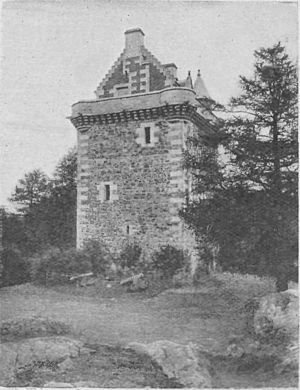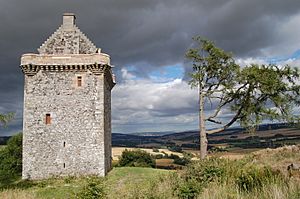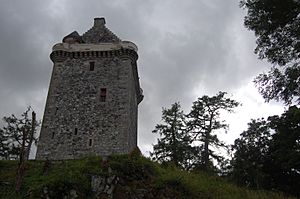Fatlips Castle facts for kids
Fatlips Castle is a historic building in the Scottish Borders. It is a type of small tower house called a peel tower. You can find it high up on Minto Crags, overlooking the River Teviot. The Turnbull family built this castle in the 1500s. They were known as Border reivers, who were families living near the border between Scotland and England. They often raided each other's lands. In 1545, during a time of conflict, parts of the area around the castle were burned.
Contents
Discovering Fatlips Castle
Fatlips Castle is a special kind of building called a peel tower. These towers were common in the Scottish Borders during the 1500s. They were built to protect families from raids by other clans. The Turnbulls of Barnhills built Fatlips Castle. They were a powerful family in the area.
Why the Name Fatlips?
The castle has a very unusual name: Fatlips! People say it got this name because the family who lived there greeted visitors in a very friendly way. They were known for being quite welcoming to everyone who came to their home.
A Castle's Journey Through Time
In 1705, Sir Gilbert Elliot bought Fatlips Castle. His family later became known as the Earls of Minto. The castle was fixed up a lot in 1857. Later, in 1897 and 1898, a famous architect named Sir Robert Lorimer worked on the inside. He made it into a place for hunting trips and a private museum. People used the building until the 1960s.
In 2011, plans were made to restore the castle again. By 2013, the top parts of the castle were successfully repaired. This included the roof and the walls around the top.
What Does it Look Like?
Fatlips Castle is a rectangular tower. It measures about 26 feet (8 meters) from north to south. It is about 32 feet (9.8 meters) from east to west. The castle has four main floors, plus an attic at the very top. Around the attic, there is a walkway built in the 1800s.
Historic Environment Scotland has officially recognized Fatlips Castle. It is called a scheduled monument. This means it is an important historical site that is protected by law.




